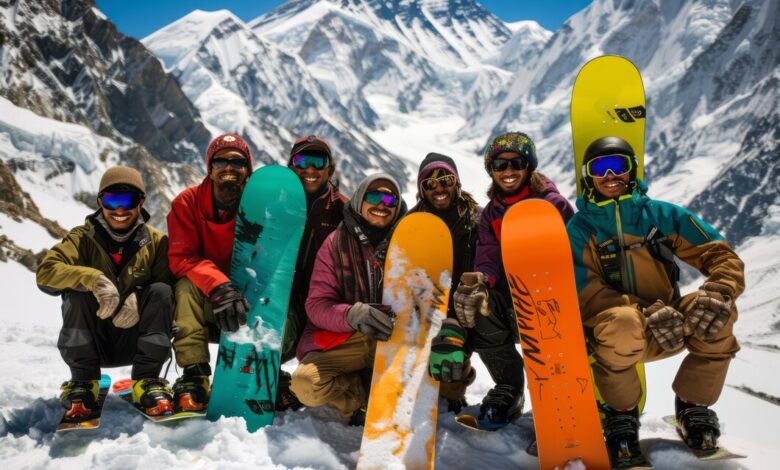What to Expect on the Annapurna Base Camp Trek: A Day-by-Day Breakdown

Embarking on the Annapurna Base Camp trek is a journey through some of Nepal’s most stunning landscapes and diverse cultural experiences. This iconic trek spans approximately 10 to 14 days, depending on your pace and itinerary, and offers a day-by-day adventure that unfolds in spectacular fashion.
On the first day, you’ll start your journey from Pokhara, a vibrant city nestled by Phewa Lake. The day begins with a scenic drive or flight to the trailhead at Nayapul. From there, a short hike through terraced fields and local villages takes you to Tikhedhunga or Ulleri, where you’ll settle in for the night. This initial trek offers a gentle introduction to the trail, providing an opportunity to acclimatize and soak in the rural beauty.
The next few days are dedicated to ascending through diverse terrain. The trail winds upward from Tikhedhunga/Ulleri to Ghorepani, passing through lush forests and charming villages. Ghorepani is renowned for its panoramic views of the Dhaulagiri and Annapurna ranges. On the following morning, an early sunrise hike to Poon Hill rewards you with breathtaking vistas of the Himalayas. The trek continues to Tadapani, where the environment becomes increasingly alpine, and the views more dramatic.
As you progress, the trek moves from Tadapani to Chhomrong, a gateway to the Annapurna Sanctuary Trek. This part of the trek involves descending into the Modi Khola Valley and then climbing steeply to Chhomrong, where you’ll encounter the majestic Annapurna South and Machapuchare (Fishtail) peaks. The next leg of the journey takes you to Dovan, passing through dense bamboo and rhododendron forests, which gradually give way to the higher, more rugged terrain.
From Dovan, you’ll trek to Deurali, where the landscape becomes more barren and the altitude begins to affect your breathing. This section of the trek introduces you to the more challenging aspects of high-altitude hiking, with the air thinning and temperatures dropping. The final push to Annapurna Base Camp takes you through the dramatic landscape of the Annapurna Sanctuary, where the trail flattens out in the shadow of the towering peaks.
At Annapurna Base Camp, you’ll be rewarded with a spectacular 360-degree view of some of the highest peaks in the world. Spend time here acclimating and taking in the grandeur of the surrounding mountains. The trek back is a reversal of the initial route, but with a newfound appreciation for the changing scenery and your own trekking achievements. The return journey includes a stay at Jhinu Danda, known for its natural hot springs, before concluding at Nayapul and returning to Pokhara.
Throughout the trek, expect varying weather conditions, from warm, sunny days to cold, crisp nights. Be prepared for physical exertion, as the trek involves significant elevation gains and losses. However, the experience is profoundly rewarding, offering a blend of natural beauty, cultural insights, and personal accomplishment.
Introduction
The Annapurna Base Camp trek is a remarkable journey that takes trekkers through a diverse range of landscapes and cultural experiences in Nepal. This trek is famed for its breathtaking mountain views, rich local culture, and varied terrain. Spanning about 10 to 14 days, depending on the itinerary and pace, the trek provides a challenging yet rewarding experience. Each day offers unique encounters, from tranquil village life and lush forests to dramatic mountain scenery. This breakdown offers a glimpse into what you can expect at the beginning of this adventure, highlighting the first few days that set the stage for an unforgettable trek to one of the world’s most iconic base camps.
Overview of the Trek
The Annapurna Base Camp trek is a journey into the heart of the Annapurna Massif, offering trekkers a close-up view of some of the highest peaks in the Himalayas. The trek typically starts from the vibrant city of Pokhara, known for its stunning lake and mountainous backdrop. The trail takes you through terraced fields, dense forests, and traditional villages before reaching the base camp, situated at an elevation of 4,130 meters (13,550 feet). The trek provides an opportunity to experience the diverse ecosystems of the region, from subtropical forests at lower altitudes to the alpine and arctic environments near the base camp. Along the way, trekkers encounter local cultures, enjoy panoramic views, and experience the changing landscapes of the Himalayas.
Day 1: Arrival in Pokhara
The first day of your Annapurna Base Camp trek begins with your arrival in Pokhara, a picturesque city set against the backdrop of the Annapurna and Machapuchare ranges. Known for its serene lakes, vibrant markets, and relaxed atmosphere, Pokhara serves as a gateway to the trek. Upon arrival, you’ll have time to explore the city, visit landmarks such as Phewa Lake and the World Peace Pagoda, and prepare for the trek ahead. You will meet your trekking team, including guides and porters, who will assist with final preparations and briefings. The day is also an opportunity to acclimatize to the local environment and gather any last-minute supplies. A restful night in one of the many comfortable lodges or hotels in Pokhara sets you up for the journey ahead.
Day 2: Drive to Nayapul and Trek to Tikhedhunga
The adventure officially begins on the second day with a drive from Pokhara to Nayapul, the starting point of the trek. This scenic drive, which takes about 1.5 to 2 hours, winds through lush landscapes and small villages, providing a glimpse of rural Nepal. Upon reaching Nayapul, you will start your trek towards Tikhedhunga, a charming village located at an elevation of 1,540 meters (5,050 feet). The trek from Nayapul to Tikhedhunga is relatively short and allows you to gradually acclimate to the trekking conditions. The trail meanders through terraced fields, crossing suspension bridges over the Modi Khola River, and passing traditional stone houses and vibrant local communities. The day concludes with an overnight stay in a local lodge in Tikhedhunga, where you can relax and enjoy the serene surroundings.
Day 3: Trek from Tikhedhunga to Ghorepani
On the third day, the trek continues from Tikhedhunga to Ghorepani, ABC Hike a village renowned for its spectacular mountain views. The journey involves a steady climb, as the trail ascends through dense rhododendron forests and picturesque terraced fields. This section of the trek is known for its challenging ascent, particularly the steep stone steps leading up to Ulleri. As you climb higher, the views of the surrounding peaks become increasingly impressive. Ghorepani, situated at an elevation of 2,860 meters (9,383 feet), is a popular stopover for trekkers, offering stunning vistas of the Annapurna and Dhaulagiri ranges. The village is also known for its welcoming teahouses, where you can rest and prepare for the next day’s trek. The evening in Ghorepani provides an opportunity to enjoy local cuisine and admire the breathtaking mountain scenery.
Day 4: Sunrise at Poon Hill and Trek to Tadapani
On the fourth day of the Annapurna Base Camp trek, the day begins early with a pre-dawn hike to Poon Hill, renowned for its spectacular sunrise views. Located at an altitude of 3,210 meters (10,531 feet), Poon Hill offers panoramic vistas of the Annapurna and Dhaulagiri ranges bathed in the golden light of dawn. The effort of waking up early and climbing to the viewpoint is rewarded with breathtaking views of snow-capped peaks and a dramatic sunrise. After soaking in the stunning scenery, you descend to Ghorepani for breakfast before continuing your trek to Tadapani. The trail from Ghorepani to Tadapani is characterized by diverse landscapes, including lush rhododendron forests and clearings that offer additional mountain views. Tadapani, situated at an elevation of 2,630 meters (8,626 feet), is a peaceful village offering splendid views of Annapurna South and Machapuchare. You’ll stay overnight in a teahouse, where you can relax and enjoy the serene surroundings.
Day 5: Trek from Tadapani to Chhomrong
Day five involves trekking from Tadapani to Chhomrong, a significant waypoint on the route to Annapurna Base Camp. The journey starts with a descent through dense forests and terraced fields, eventually reaching the Modi Khola River. After crossing the river, the trail ascends steeply towards Chhomrong, which sits at an elevation of 2,170 meters (7,119 feet). This village is an important gateway to the Annapurna Sanctuary and offers stunning views of the Annapurna South and Machapuchare peaks. The trek to Chhomrong involves some steep sections and several ups and downs, but the vistas and the promise of reaching closer to the base camp make the effort worthwhile. In Chhomrong, you’ll find several teahouses that provide comfortable lodging and meals, preparing you for the next leg of the journey.
Day 6: Trek from Chhomrong to Dovan
On the sixth day, the trek from Chhomrong to Dovan takes you deeper into the Annapurna Sanctuary. The trail descends initially to the Chhomrong Khola and then climbs gently through bamboo forests. As you gain altitude, the terrain changes to a more rugged and alpine environment. Dovan, situated at an elevation of 2,600 meters (8,528 feet), marks a transition point as the landscape becomes more remote and less inhabited. The journey through this segment provides opportunities to observe the changing flora and fauna, including lush bamboo and rhododendron forests. Dovan’s teahouses offer a well-deserved rest after a day of trekking through increasingly challenging terrain. This stop is crucial for acclimatization and preparation for the higher altitudes ahead.
Day 7: Trek from Dovan to Machapuchare Base Camp
Day seven brings you from Dovan to Machapuchare Base Camp, which serves as a crucial stop before reaching Annapurna Base Camp. The trek from Dovan involves a steady climb through a dramatic landscape marked by rocky terrain and sparse vegetation. As you approach Machapuchare Base Camp, situated at 3,700 meters (12,139 feet), the surroundings become increasingly rugged and spectacular. Machapuchare Base Camp is known for its proximity to the imposing Machapuchare (Fishtail) Peak and offers stunning views of surrounding peaks. The camp provides a closer look at the Annapurna Sanctuary, with its dramatic cliffs and snow-covered summits. The higher altitude and reduced oxygen levels begin to make their presence felt, but the awe-inspiring scenery provides ample motivation.
Day 8: Trek from Machapuchare Base Camp to Annapurna Base Camp
On the eighth day, you will trek from Machapuchare Base Camp to Annapurna Base Camp Trek 6 Days, the ultimate destination of your journey. The trek from Machapuchare Base Camp to Annapurna Base Camp involves a gradual ascent through the heart of the Annapurna Sanctuary. The trail provides magnificent views of the surrounding peaks, including Annapurna I, II, and III, as well as the South Face and other notable summits. Annapurna Base Camp, located at an elevation of 4,130 meters (13,550 feet), is a breathtaking destination where you can marvel at the panoramic views of the Annapurna Massif and enjoy the serene high-altitude environment. The base camp is a fitting culmination of the trek, providing an opportunity for rest and reflection amid the grandeur of the Himalayas. This day offers a moment to celebrate your achievement and take in the incredible surroundings before preparing for the return journey.
Day 9: Explore Annapurna Base Camp
Day nine is dedicated to exploring Annapurna Base Camp, the pinnacle of your trekking adventure. Nestled at an elevation of 4,130 meters (13,550 feet), this base camp offers unrivaled views of the Annapurna Massif and surrounding peaks. The day begins with the opportunity to soak in the breathtaking panorama of towering snow-capped mountains, including Annapurna I, Annapurna South, Machapuchare (Fishtail), and several other giants of the Himalayas. This day at the base camp is a chance to take a leisurely stroll around the area, capture stunning photographs, and relish the sense of accomplishment that comes with reaching such a remote and majestic location. You can also visit the nearby glacier and enjoy the serene high-altitude environment. The base camp serves as a perfect spot for reflection and admiration of the vast, rugged beauty that surrounds you. As the day comes to a close, you’ll enjoy a well-deserved rest and prepare for the descent back through the Annapurna Sanctuary.
Day 10: Descend to Bamboo
On day ten, you begin the descent from Annapurna Base Camp to Bamboo, retracing your steps through the Annapurna Sanctuary. The trek from Annapurna Base Camp to Bamboo involves a significant descent, which provides a different perspective of the landscape compared to the ascent. The trail descends through lush forests and across various terrain types, gradually moving away from the high-altitude environment. Bamboo, situated at an elevation of 2,340 meters (7,677 feet), is a serene stopover point where you can rest and recover from the previous day’s exertions. The descent is easier on the body but requires careful navigation to avoid strain on the knees and legs. Upon arrival in Bamboo, you’ll find cozy teahouses that offer comfortable lodging and meals, allowing you to relax and prepare for the next day’s trek.
Day 11: Trek from Bamboo to Jhinu Danda
Day eleven involves trekking from Bamboo to Jhinu Danda, a village renowned for its natural hot springs. The trek from Bamboo to Jhinu Danda covers a range of terrain, including gradual descents and climbs through verdant forests and terraced fields. Jhinu Danda, located at an elevation of 1,780 meters (5,839 feet), offers a welcome respite with its hot springs, where trekkers can soak and relax their muscles after days of trekking. The village provides a comfortable place to stay, and the hot springs offer a rejuvenating experience that is both soothing and invigorating. The evening in Jhinu Danda allows you to unwind and enjoy the local hospitality, reflecting on your journey through the Annapurna region.
Day 12: Trek to Nayapul and Drive to Pokhara
On the final day of the trek, you will trek from Jhinu Danda to Nayapul, where you will catch a drive back to Pokhara. The trek to Nayapul is relatively straightforward, consisting of a descent through picturesque villages and terraced fields. The journey back offers one last opportunity to appreciate the beauty of the Nepali countryside. Upon reaching Nayapul, you will board a vehicle for the drive back to Pokhara. This drive takes you through scenic landscapes and rural areas, offering a final glimpse of the region you’ve explored. Arriving in Pokhara marks the end of your trek, and you can spend time relaxing in the city, enjoying its vibrant atmosphere, and reflecting on the incredible experience you’ve had.
Conclusion and Reflections on the Journey
The Annapurna Base Camp trek is a profound adventure that combines challenging physical exertion with unparalleled natural beauty and cultural richness. Reflecting on the journey, you’ll appreciate the diverse landscapes, from lush forests and terraced fields to high-altitude deserts and snow-capped peaks. The trek provides not only stunning views but also personal growth and a deep sense of achievement. Interactions with local communities and fellow trekkers add to the richness of the experience. As you conclude your trek, the memories of the majestic Annapurna Massif, the camaraderie shared on the trail, and the sense of accomplishment will stay with you long after you return home. This trek is not just a physical challenge but a memorable journey through one of the world’s most spectacular regions.
Also Read: The Importance of the Silver Visa in 2024




